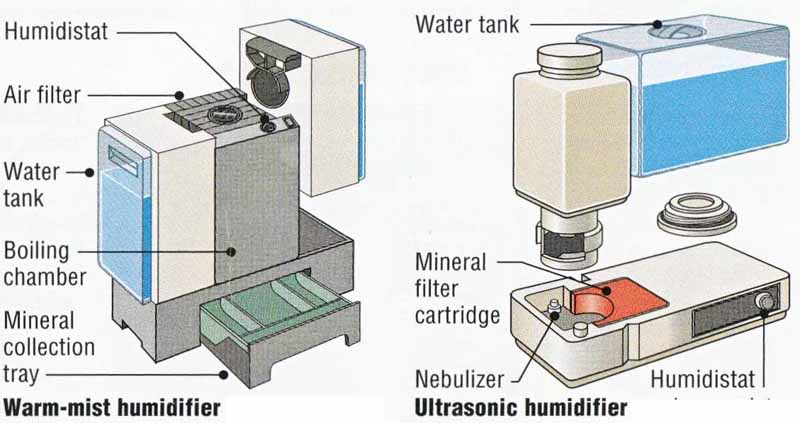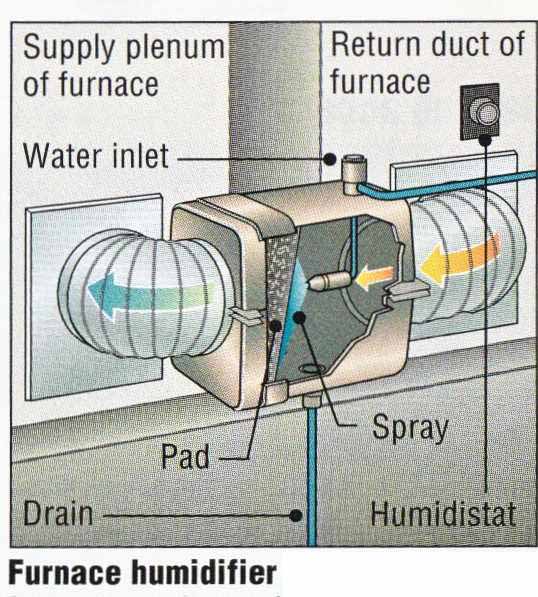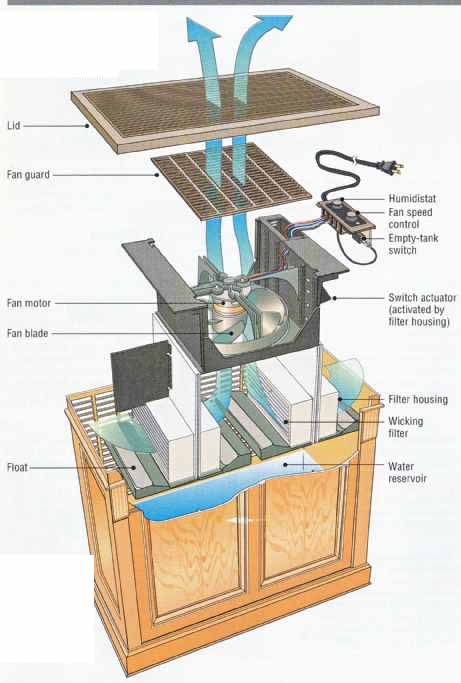
To gain access to internal parts, unplug humidifier; open lid and lift out fan unit. Unclip fan guard to reach fan. Unscrew control-panel cover to reach controls.
Note: Details of repair and disassembly may vary, depending on appliance model, If your humidifier differs markedly from this one or these en the facing page, see Appliance repair basics.
Some components:
- Humidistat
- Fan speed control
- Empty-tank switch
- Switch actuator (activated by filter housing)
- Filter housing
A humidifier helps ease skin and nasal irritations and can prevent dry-house problems, such as shrinking wood joints. But a humidifier can create health hazards (see Environmental hints). One of the safest types is the wicking-filter evaporative unit shown at left. It has disposable floating filters kept wet by wicking water and a fan that distributes the vapor evaporating off them. The humidifiers on the facing page use other moisture-delivery methods.
Most humidifier problems result from dirty or damaged evaporative foam or filters. Problems may also involve the fan, the fan speed switch, the empty- tank switch, which turns off the unit when the tank is empty, and the humidistat, which senses humidity and turns the unit on or off at the set point. All are easy to test and fix or replace.
CAUTION: Unplug a humidifier and empty any water before testing or repairing it.
Fan and fan motor:
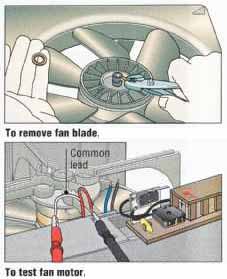
To remove fan blade, pry off grommet; then, wearing safety goggles, use pliers to release spring clamp. On some units, loosen setscrew.
To test fan motor, detach its leads from control. With VOM on RX1, probe common lead and other leads in turn. Look for moderate resistance.
Testing control switches:
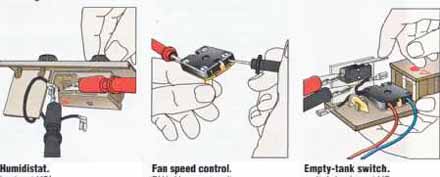
Humidistat. Free one humidistat lead, set VOM on RX1, and clip probes to terminals. Turn knob; look for VOM to jump from zero to infinity or vice versa when you hear a click. Partial or steady reading signals a fault (unless air is too humid or too dry).
Fan speed control. Set VOM on RX1. Unmount switch. Insert a probe in L terminal; touch other terminals in turn. With control in Oft position, look for infinity reading at each terminal. In each other control position, reading at one terminal should be zero.
Empty-tank switch. Detach switch leads, set VOM on RX1, and clip probes to terminals. VOM should read zero ohms when you hold switch lever down, infinity when you release lever (as actuator does when water level drops).
==
ENVIRONMENTAL HINTS:
Don’t poison your home’s air:
If not kept clean, humidifiers can spew bacteria, mold, fungi, and mineral dust into the air. Newer evaporative models have disposable filters that trap minerals and discourage microbial growth; you must replace the filters and clean the tank with an antibacterial solution.
Older evaporative models have hard-to-clean foam belts and drums that can become breeding grounds for micro organisms. Ultrasonic models also need frequent cleaning (usually every refilling). If an ultrasonic unit doesn’t have a filter cartridge to de-mineralize water, use distilled water. Warm-mist units are generally safe; they boil the water, which distills out minerals and kills microbes.
A furnace unit that uses water-soaked evaporative media may share the hazards of a portable. One that uses a continuous spray of mist and has a drain line is safer.
==
Troubleshooting:
SYMPTOM: |
POSSIBLE CAUSE: |
SOLUTION: |
Wont run Runs but doesn’t humidity Noisy |
Power off at outlet or faulty power cord Humidistat set too low Faulty lid switch (some evaporative units) Faulty empty-tank switch Faulty fan speed control switch Faulty humidistat Faulty fan motor Too little water in reservoir Clogged drive belt (drum evaporative unit) Faulty shaded-pole belt motor (belt evaporative unit) Faulty drive train (belt evaporative unit) Loose fan blade Faulty fan motor or foreign object in motor Clogged drive belt (drum evaporative unit) Fan motor bearings dry |
See General Troubleshooting Set higher Test and replace like on-off switch (see General Troubleshooting) Test and replace Test and replace Test and replace Test and replace Refill. Clean. K Or replace belt Test and replace (below; see also General Troubleshooting) Fix loose gear. Tighten. Test and replace Or remove object Clean. Or replace belt Put 2 or 3 drops of non-detergent SAE 20 oil in oil hole |
[Degree of difficulty: Simple Average Complex --- Volt-ohm meter required]
Other common types of humidifiers:
Humidifiers vary widely in appearance and in how they deliver moisture. But most have humidistats, and many have fans, fan speed controls, and empty- tank (or float) switches, which can be tested like similar parts in the model shown on the facing page. Problems specific to each humidifier type are described below. Clean a drum or belt evaporative model, or an ultrasonic unit, often; use an antibacterial solution. See Environmental Hints, above.
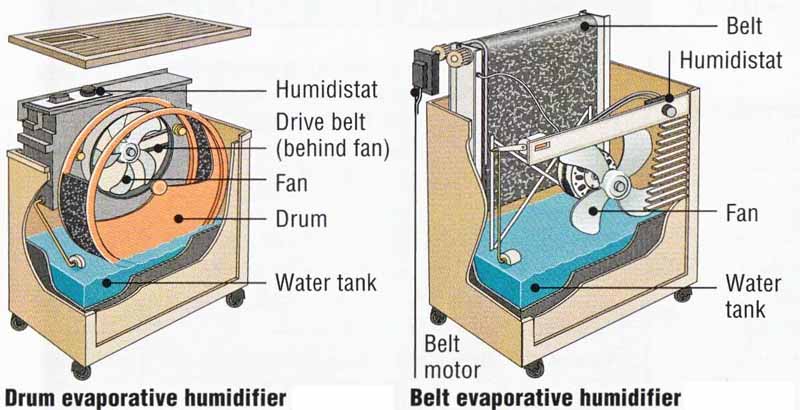
Drum evaporative humidifier rotates sponge-covered drum through water as fan draws air over it. Clean clogged drive belt with 1:1 white vinegar—water mix. Replace clogged sponge.
Warm-mist humidifier boils water and mixes the steam with air to cool it. Mineral deposits tend to build up in the boiling chamber. Clean it with soft brush and 1:1 vinegar-water mix.
Furnace humidifier takes some air from return duct, adds moisture to it, and mixes it with hot air in plenum. If unit falters, test humidistat. On many models, also test fan and float switch.
Belt evaporative humidifier rotates a sponge belt through water as fan blows air through it. Test a nonworking belt motor. Secure a loose gear on belt drive train with epoxy.
Ultrasonic humidifier produces mist with a high-frequency vibration. The nebulizer (vibrator) is a common trouble spot; clean it weekly. Also replace mineral filter, if any, regularly.
